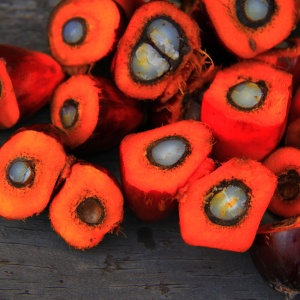
According to this study of oil palm plantations in Colombia, converting pasture to oil palm plantation is almost carbon neutral, because declines in soil organic carbon are offset by gains in oil palm biomass over a period of several decades. The authors argue that planting oil palm on former pasture land is preferable to converting rainforest to plantations, as regards greenhouse gas emissions.
In contrast to Indonesia and Malaysia, where oil palm is often planted on areas of cleared rainforest, plantations in Colombia (the fourth largest producer of palm oil) have tended to be on former pasture land (which itself was formerly savannah), and also directly on areas of former savannah.
The figure below shows that, on oil palm plantations in Colombia established on former pasture, the level of soil carbon initially declines and then reaches an equilibrium.
 Image: Figure 1, Quezada et al. Soil carbon stocks after pasture conversion into oil palm plantations at 0 cm to 50 cm depth.
Image: Figure 1, Quezada et al. Soil carbon stocks after pasture conversion into oil palm plantations at 0 cm to 50 cm depth.
Total ecosystem carbon (both above and below ground) increases during the growth of a batch of oil palm trees and decreases when the trees are replanted, as shown in the figure below. Averaged over time (purple band below), total ecosystem carbon remains at roughly the same level that was measured in pastures (orange diamond below). Total ecosystem carbon in plantations, averaged over time, declines by only 0.5 ± 8.8 Mg C ha−1 relative to pasture. In contrast, when rainforest is converted to oil palm plantation, the loss in total ecosystem carbon is much higher, at 173 Mg C ha−1 (based on figures from Sumatra).
 Image: Figure 3, Quezada et al. Total ecosystem carbon (TEC) stocks. TEC in OP plantations and pastures includes above- and belowground biomass and SOC stocks down to 50 cm (but not dead trees after replanted). The purple band indicates the time-averaged TEC stocks during the 56 years of oil palm cultivation.
Image: Figure 3, Quezada et al. Total ecosystem carbon (TEC) stocks. TEC in OP plantations and pastures includes above- and belowground biomass and SOC stocks down to 50 cm (but not dead trees after replanted). The purple band indicates the time-averaged TEC stocks during the 56 years of oil palm cultivation.
Abstract
Alternatives to ecologically devastating deforestation land use change trajectories are needed to reduce the carbon footprint of oil palm (OP) plantations in the tropics. Although various land use change options have been proposed, so far, there are no empirical data on their long-term ecosystem carbon pools effects. Our results demonstrate that pasture-to-OP conversion in savanna regions does not change ecosystem carbon storage, after 56 years in Colombia. Compared to rainforest conversion, this alternative land use change reduces net ecosystem carbon losses by 99.7 ± 9.6%. Soil organic carbon (SOC) decreased until 36 years after conversion, due to a fast decomposition of pasture-derived carbon, counterbalancing the carbon gains in OP biomass. The recovery of topsoil carbon content, suggests that SOC stocks might partly recover during a third plantation cycle. Hence, greater OP sustainability can be achieved if its expansion is oriented toward pasture land.
Reference
Quezada, J.C., Etter, A., Ghazoul, J., Buttler, A. and Guillaume, T., 2019. Carbon neutral expansion of oil palm plantations in the Neotropics. Science Advances, 5(11), p.eaaw4418.
Read the full paper here. See also the Foodsource building block What is land use and land use change?












Post a new comment »